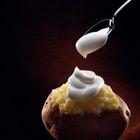
A lot of recipes call for lemon juice or vinegar to be added to milk, which makes it curdle and simulate buttermilk in your recipe. If you've ever done that, and watched the milk curdle visibly in just a few minutes, you might be reluctant to add acidic ingredients to other dairy products. In the case of cultured products such as sour cream, it's safe, -- because the cream is already acidified.
Sour Cream
Sour cream is usually made by separating heavy cream from milk, and deliberately culturing it with desirable bacteria. Over a period of hours, the bacteria convert natural sugars in the cream to acid, producing a number of appealing flavor molecules in the process. The acidity also coagulates milk proteins in the cream, so they form a soft gel and give the cream its characteristically thick texture. The bacteria used in sour cream produce less acidity than the related types used in yogurt, so sour cream has relatively mild tang.
Lime Juice
Sour cream makes a good complement to a variety of spicy and strongly flavored foods, because its mild richness makes a contrast to the spicy flavors. It also helps damp down the heat of chili peppers. In many cases, sour cream makes an even better complement to the food if lime juice is added, giving it a sharper and fruitier tang. The lime juice doesn't cause sour cream to curdle further, because its proteins have already coagulated or "set" and lime juice alone isn't strong enough to break those protein bonds.
Curdling Sour Cream
Heating, on the other hand, will make sour cream curdle almost immediately. The combination of heat and acidity makes the milk proteins tighten and contract, just as a piece of bacon shrivels on the griddle. There is only about 20 percent fat in sour cream, and the milk proteins in the remaining 80 percent are quickly affected by heat and the cream's own acidity, even without added lime juice. The same holds true for yogurt. A product similar to sour cream, the French "creme fraiche," is better suited to hot dishes because it has a higher fat content and resists curdling.
Stabilizing Sour Cream
If you want to use sour cream in hot dishes, you have two options. One is to add the sour cream immediately before serving, as you would by adding a dollop of cream to a bowl of borscht. The other option is to stabilize the sour cream, so it can take the heat without curdling. For each cup of sour cream you want to use, whisk one tablespoon of cornstarch into three tablespoons of water and then stir the slurry into your sour cream and heat it very gently over low heat. Alternatively, you can stir one beaten egg white into 1 to 2 cups of sour cream. The same techniques work with yogurt.
Making Creme Fraiche
A second alternative is to use creme fraiche. It is common in parts of Europe but hard to find in the United States, so it's easier to make your own. Use heavy whipping cream, at 36 to 38 percent milk fat. Warm the cream to just above room temperature, then stir in two tablespoons of cultured buttermilk. Refrigerate the cream at least overnight, or for up to five days. The flavor is not exactly the same as for true creme fraiche, but it can be used without fear in hot dishes.
Related Articles

Can You Bake Greek Yogurt?

What Can Be Used as a Substitute for ...

What Else Could You Use Besides Cream ...

What Does Rennet Do in Ice Cream?
Cream vs. Creamer
The Difference Between ...

Substitute for Heavy Whipping Cream in ...

How to Use a Cream With Arginine

Calories in a Tablespoon of Cream Cheese

What Makes Cream Liqueur Curdle in ...
Clotted Cream Vs. Double Cream

How to Bring Cream to a Boil

What Happens if I Forget to Refrigerate ...

How to Make Sour Cream Out of Heavy ...

Why Does Some Alcohol Curdle Cream?

Types of Curly Perms

How to Make Stiff Peaks in Whipped Cream

How to Make Facial Wax at Home

How to Make Scalded Cream

Heavy Cream vs. Milk in Baking
References
- On Food and Cooking: The Science and Lore of the Kitchen; Harold McGee
- The Professional Pastry Chef; Bo Friberg
Writer Bio
Fred Decker is a trained chef and certified food-safety trainer. Decker wrote for the Saint John, New Brunswick Telegraph-Journal, and has been published in Canada's Hospitality and Foodservice magazine. He's held positions selling computers, insurance and mutual funds, and was educated at Memorial University of Newfoundland and the Northern Alberta Institute of Technology.
Photo Credits
Stockbyte/Stockbyte/Getty Images